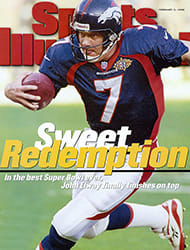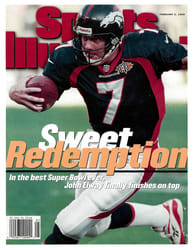Hockey's Little Helpers
At 6:30 on game nights in Montreal, as the fans start streaming
into the Molson Centre, as the TV sportscasters fidget while
waiting to deliver their live reports, as the hot dogs grill in
the press lounge, Canadiens goaltender Andy Moog goes through
his pregame routine in the dressing room. He takes two Sudafed
tablets and washes them down with a cup of water--it is not a
question of health but of habit. Moog took Sudafed for the first
time six or seven years ago, when he was with the Boston Bruins,
because he had a terrible head cold. Since then, his remedy has
become his ritual. Four other Canadiens also reach regularly for
Sudeys, as they sometimes call them, to kick-start their motors,
to get ready to play. For these men a game face includes an open
mouth and a couple of hockey's little helpers.
A similar scene is being played out in dressing rooms throughout
the NHL. The exact number of players who use Sudafed, a
nonprescription drug that contains the stimulant
pseudoephedrine, in an effort to boost their performance on the
ice, is unclear. Two NHL trainers estimate that before a game
20% of the league's players routinely take over-the-counter
medications that contain pseudoephedrine, not to combat the
sniffles, as the manufacturers intended, but to feel a little
buzz. The NHL, however, disputes that figure, saying the
percentage of players using drugs such as Sudafed is much lower
and that they use them for medicinal purposes only.
The brand names vary—pseudoephedrine can be found in dozens of
cold remedies—‚but Sudafed remains the most popular choice for
players who want a pick-me-up. It's the NHL's dirty little
secret, and with the Olympics imminent, it is of great concern
to the league because although Sudafed is legal, it is on the
Olympic list of banned substances. Consider the following:
Anecdotal accounts of Sudafed abuse in the league abound. A
former coach says one of his players built up such a tolerance
to the medication that he had to gobble 20 pills to get the
desired boost.
"There are all kinds of overdose stories—guys not being able to
finish the first period because they get the shakes, paranoia,
anxiety," says Detroit Red Wings athletic trainer John Wharton,
who's been with the club since February 1991. "There are some
guys who have been able to tolerate [large doses of
pseudoephedrine]. The most I've seen a player take is eight
pills. That dose would put some people in the hospital." Wharton
says he has seen four or five abusers in the last seven years.
Jari Kurri, the respected 17-year veteran right winger of the
Colorado Avalanche, says some of the dirty play in recent years
might be a result of players having had something more than the
usual competitive juices flowing through their systems. He
suggests a link between the use of pseudoephedrine and the
increasing lack of respect NHL players have shown each other in
this decade. "You take it, you get hyped up," says Kurri, who
also says that he took Sudafed once before a game last season
when he was with the Anaheim Mighty Ducks. "I don't know if the
stickwork, the dirty hits, are because of that, but I think it's
something the league should look into."
Montreal right wing Mark Recchi sees no correlation between
pseudoephedrine and dirty play but doesn't deny that Sudafed
gets him going. "You get a bit of an upper from it," says
Recchi, who no longer takes the medication but admits that at
one time he used it every 10 or 15 games. "You get pretty wired
up. Sometimes it gets you a little emotional on the ice, a
little too fired up."
Brian Savage, a left wing on the Canadiens, takes two Sudafeds
before every game at roughly the same time as Moog. Savage says
he started the routine three years ago, his second season in the
league. "I'm not sure if it pumps me up anymore," he says,
"[but] if I'm a little groggy, it brings me up." Sometimes the
trouble is coming down. After a game that ends at about 10:15
p.m., Savage can't fall asleep until 2 or 2:30 a.m. "I go out
for dinner, have a glass of wine," he says. "Then I can fall
asleep."
[pullquote][quote]While the pills
may not be physically addictive, the high that the players get
from the medication is.[/quote][/pullquote]
With the Nagano Olympics scheduled to open on Feb. 7 the abuse
of over-the-counter drugs has become a delicate issue for the
NHL. The league, in its initial Olympic involvement, is
providing players for six Dream Teams for Nagano, and the last
thing it needs is a doping scandal. Sudafed use could lead to
one. The NHL, in conjunction with the players' association,
tested prospective Olympians during training camps and has
continued with random testing during the season in hopes of
preventing the embarrassment of a failed test at the Games. In
Nagano a positive drug test after a game by a player would
result in the suspension of that player from the Olympics and in
his team's forfeiting that game. If a player tested positive
after a medal-round game, he and his teammates could be stripped
of their medals.
An IOC drug-testing official told SI that if a person ingested a
small quantity of pseudoephedrine—the normal dosage in two
regular-strength Sudafed pills—traces of the stimulant could
show up in his urine sample up to a month later. However, the
official said that "after about a week" it was unlikely that
enough would show up to produce a positive result.
Still, NHL Olympic participants and trainers are taking no
chances with Sudafed and its chemical cousins. The Canadiens
have changed their protocol for the distribution of
over-the-counter cold remedies this season, requesting that
players get them only from the medical room even though anyone
can pick up a box of 24 Sudafed extra-strength decongestant—one
of eight Sudafed brands marketed in Canada—for $6.99 at a
pharmacy. (Last week one Montreal player had a bottle containing
Sudafed tablets on a shelf in his locker.) Several Olympians,
including New Jersey Devils goaltender Martin Brodeur and
Colorado right wing Adam Deadmarsh, haven't taken the medication
even to fight winter colds this season because of the
approaching Games, according to newspaper accounts and team
sources. Wharton says, "We've been super cautious with [Red
Wings Olympians Steve] Yzerman and [Brendan] Shanahan for
months."
The impish Shanahan, though, was less circumspect in a Jan. 18
interview with TSN in Canada. When asked if he enjoyed teaming
with U.S. players on the North American squad in the All-Star
Game, he cracked that it gave him an opportunity to "see if
anybody's popping Sudafeds in the American drinks."
Shanahan was joking, but the casual approach to over-the-counter
medications is no laughing matter. The effects of
pseudoephedrine are similar to what Canadian Olympic team doctor
Eric Babins calls its "first cousin"—adrenaline, or
norepinephrine: It can increase breathing capacity by shrinking
and unblocking nasal passages and dilating the bronchial
passages while raising the heart rate and blood pressure. The
drug stimulates the sympathetic nervous system, which controls
involuntary muscles and responses, including the fight-or-flight
response so critical in the wild. Players who have used Sudafed
say that if they take the medication an hour before a game, they
begin to notice its effects 35 or 40 minutes later, during
warmups. Doctors say pseudoephedrine is at its most potent about
two hours after it is taken, although the drug remains active in
the system from eight to 16 hours, depending on the dosage, the
formulation and the individual. Potential side effects include
tremors and anxiety, but there appear to be no long-term effects
unless the user already has a cardiac condition. While the pills
may not be physically addictive, the high that the players get
from the medication is.
According to players and medical personnel, Sudafed began to
appear in NHL dressing rooms in the mid-to-late 1980s. The
approach to the medication at the time was surprisingly relaxed
on some teams. When Wharton joined the Red Wings as their
strength and conditioning coordinator, he says, Sudafed tablets
sat on the table in the dressing room "like a bowl of fruit. But
we got rid of them right away." He estimates that three quarters
of the Detroit players at the time used Sudafed before a game.
"[When I played for Edmonton], I remember somebody walking [from
the back of the dressing room] with a little jar, and he used to
rattle it, and it sounded like a snake," says Moog, who spent
five full seasons with the Oilers, from 1982-83 to '86-87. "We
used to call [the tablets] 'rattlers.' [He'd say,] 'Anybody want
a rattler?'"
The use of Sudafed probably crested three or four years ago, not
long after the issue of over-the-counter medication was
discussed at a meeting of the NHL Physicians Society. "There was
a concerted effort among the doctors at the time to tell players
that [misusing the medication for a boost] was not a good idea,"
says Terry Groves, the Calgary Flames' team internist since
1980. In the early 1990s, Groves says, a notice was posted in
the Calgary dressing room that cold remedies, specifically
Sudafed, would not be dispensed by the trainers. He says he sees
no current evidence of Sudafed use by Flames players.
"We're trying to get across our message," says Gaetan Lefebvre,
the Canadiens' athletic trainer, who keeps a card handy listing
all the over-the-counter medications proscribed by the IOC.
"Those medications are for medical purposes. If you're looking
for an edge, try getting it by working out in the gym."
But if the message about misusing Sudafeds is being spread, not
all NHL players are listening. Some have merely abandoned
Sudafed for other legal products that provide the same boost.
Players are using various alternatives—including Up Your Gas
tablets—that contain the Chinese herb Ma-Huang and are
available at health-food stores. "Some of the younger players
are taking a more holistic, natural approach," Moog says of the
switch from Sudafed to a naturally occurring form of ephedrine,
a stimulant with properties similar to pseudoephedrine, which
also could produce a positive drug test at the Olympics.
Even a squeaky-clean Olympics will not mask the fact that
hockey's little helpers are part of the NHL scene. They might
not be the thinking man's choice—"Guys don't need it if they're
healthy in their [heads]," says Red Wings center Igor
Larionov—but they are an option.
COLOR PHOTO: BURK UZZLE [Hockey pucks and Sudafed tablets]
COLOR PHOTO: DIGITALLY ENHANCED PHOTO BY AL BELLO/ALLSPORT "You get pretty wired up. Sometimes it gets you a little emotional on the ice, a little too fired up." [Photomontage of hockey player, puck and Sudafed tablets]


